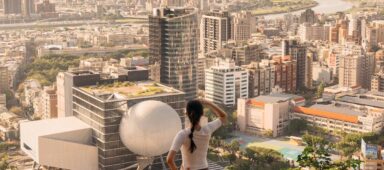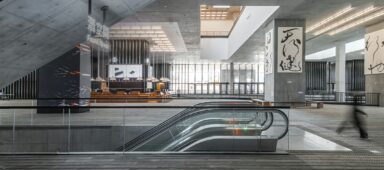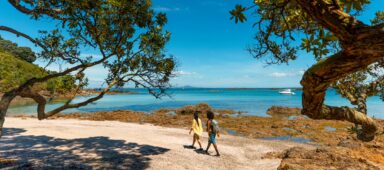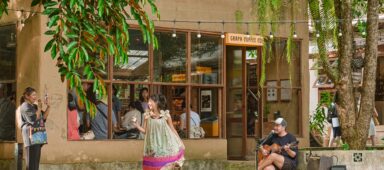Artist and photographer Acacia Diana soaks up the wonders of Da Nang, and shares some tips for capturing the spirit of this lively central Vietnamese city.
Photography: Acacia Diana
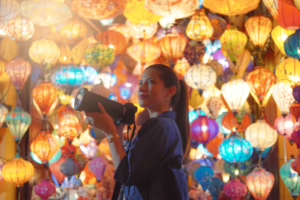
Central Vietnam’s coastal city of Da Nang, says Acacia Diana, is a multi-sensory experience that can be a lot to take in. Emerging from the airport, she heard the sound of relentless traffic even before she could see it. Vendors wearing the country’s iconic conical hats pushed carts of colourful and fragrant street food, their various aromas mingling in the air. She could almost feel the crackling of the city’s high energy. “If you really want to dive into a dynamic part of Asia,” she says, “Da Nang would be a great option.”
The London-based Malaysian photographer – who has worked with numerous global brands and humanitarian missions, and has been an ambassador for Canon – was on the ground for an assignment with Malaysia Airlines, photographing cabin crew across one of the cities in the airline’s latest roster of exciting new destinations.

This year the airline launched three new destinations from Kuala Lumpur: Chiang Mai in northern Thailand, the Maldives and Da Nang, the buzzy metropolis that has in recent years made waves as a holiday destination. Often considered the capital of Vietnam’s central coast, Da Nang’s sandy beaches, modern infrastructure and long dry season have made it a destination with one of the highest rates of returning tourists in the country.
The city is especially popular among creatives like Acacia, who find plenty of inspiration in vibrant pockets such as Con Market, a dynamic hub of 2,000 kiosks of local food, dried seafood, textiles and souvenirs.
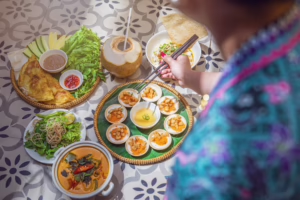
A walk down the storied Bach Dang Street, running west of the Han River, evokes a sense of the city’s former life as an important trading port, and provides a glimpse into Da Nang’s promising future as one of Vietnam’s great cultural and commercial centres.
Da Nang is also the gateway to some of Vietnam’s most beautiful gems, including the picturesque ancient town of Hoi An and the citadel city of Hue, the country’s former imperial capital.
Da Nang is a photographer’s dream, and this assignment to capture its sensorial delights came at the perfect time for Acacia. The past few years have been especially challenging for her. Dealing with a stalker while she happened to be in Malaysia turned into a high-profile case that led to both a landmark ruling and a new anti-stalking law in the country, but the experience had diminished her confidence. Her mental health had suffered and she felt depleted of energy. “I didn’t touch my camera for a long time,” she recalls.

Planning the shoot in Da Nang helped coax her out of a deeply isolating experience. “You can live life at a low base, but you want to live life at a high frequency where you really enjoy life and relish it,” she says. “I wanted to find magic and inspiration again.”
The quest to capture Da Nang’s magic brought Acacia and the crew to some of the most stunning attractions in the area. The Chua Linh Ung Pagoda, for instance, a stunning temple complex on the Son Tra Peninsula, known for its natural forests and hidden beaches, features the tallest Quan Am (Lady Buddha) statue in Vietnam.
Some eight kilometres south of Da Nang’s city centre, the picturesque Marble Mountains comprises five limestone peaks, karst formations named after the five elements – metal, wood, water, fire and earth. Carved into the mountains is a network of 10 terrestrial and subterranean pagodas, thick with the scent of slow-burning incense, that date back to the 17th century.
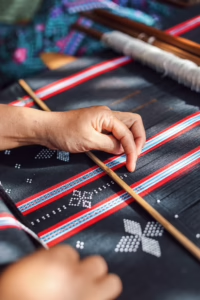
Further south, the Unesco World Heritage Site of Hoi An is exceptionally photogenic, the soft glow of multi-coloured lanterns at dusk echoing its rich history of a once-prosperous trading settlement. The combination of Chinese and Japanese aesthetics with local craftsmanship has resulted in a flamboyant and colourful visual style. At a nearby 300-year-old village, Acacia witnessed ethnic Cham people continuing a long-cherished tradition of weaving high quality silk – light, smooth, luxurious to the touch.
For Acacia, there was no shortage of inspiration in Da Nang. At Man Thai Beach, she soaked up local life, catching the lively morning scene of fishermen bobbing back to shore in coracles (teacup-shaped boats) and fishmongers selling the freshest catch of the day, their baskets laid everywhere on the cream-coloured sand.

While shooting Da Nang’s iconic Dragon Bridge as it breathed out fire in a spectacular night-time show, she was reminded that chaos can be a gift. “We learned that after fire, the dragon shoots water,” Acacia recalls, laughing. “So I scrambled to wrap my gear in protective plastic. My battery was running low. An uncle [older gentleman] knocked out my tripod. Everything was happening. When the dragon finally roared with fire, we were all startled. Luckily, I was shooting at a super-high-speed shutter and captured a moment when my subject, April, was looking up at the dragon in awe and surprise. And she wasn’t even acting.”
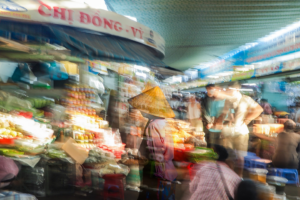
And although the Golden Bridge in Ba Na Hills – the mountaintop re-creation of French Indochina – is one of the most photographed places in all of Vietnam, arriving in the early morning to find it shrouded in mist made for an almost mystical experience. “I imagine how it would really ignite your sense of wanderlust and sense of adventure,” Acacia says.
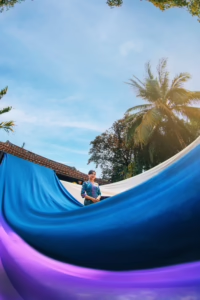
But it was in the ethnic-community village of Co Tu at the foot of Ba Na Hills where she felt something powerful and transformative. “That was mind-blowing for me because it was so different from what I expected,” she says. “And the people were so warm and welcoming, it really touched me to my core.”

The Co Tu people, also formally called the Katuic people, are an ethnic minority known for intricate weaving, basketry and stunning minimalist wooden sculptures. The artworks accentuate the beauty of raw wood and elements, and are inspired by the religious beliefs, geography and fauna of the region.

Life in their charming village – people cooking, children playing – had an otherworldly serenity and purity to it. As the sun set, the hosts started a bonfire. A woman began to sing, and soon a man joined her, their song accompanied by wooden flutes and a guitar. “The combination of the sounds had such an enchanting quality to it that I completely forgot I was photographing,” Acacia says. “It was nothing short of magical.” With reporting from Mervin Lee

